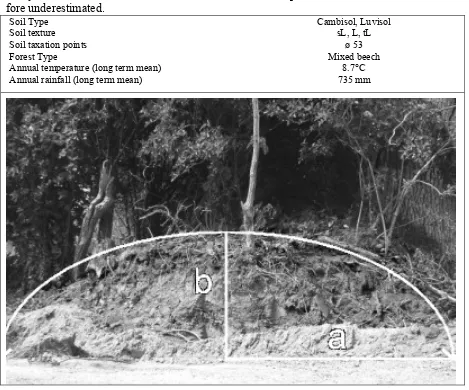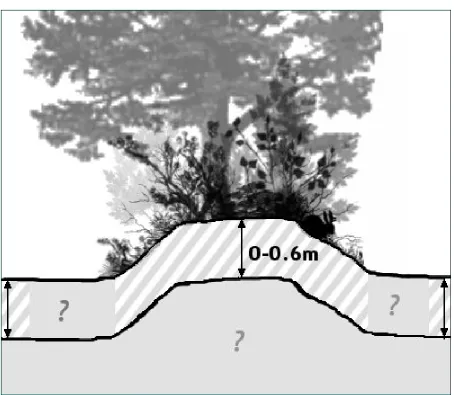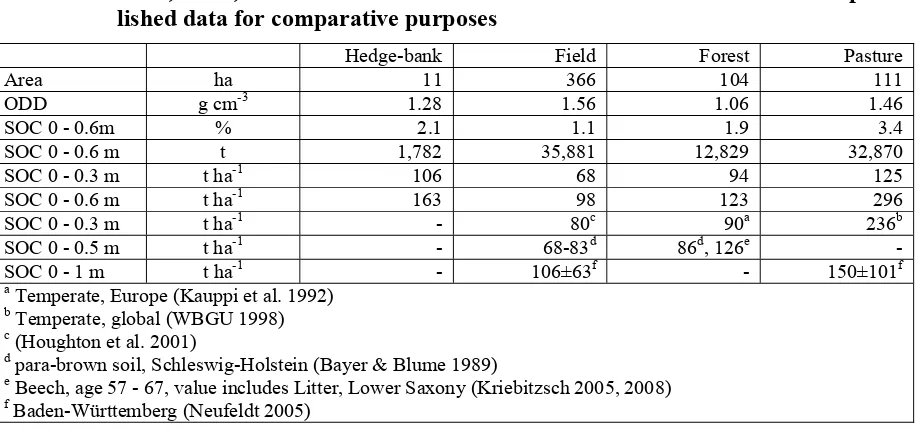Soil organic carbon stocks in hedge-banks as agricultural marginal areas
Soil organic carbon stocks in hedge-banks as
agricultural marginal areas
HANS MARTEN PAULSEN1 UND BENJAMIN BAUER1
1 Institut für Ökologischen Landbau, Johann Heinrich von Thünen-Institut, Bundesforschungsinstitut für
Ländli-che Räume, Wald und FisLändli-cherei, Trenthorst 32, 23847 Westerau, hans.paulsen@vti.bund.de
1
Zusammenfassung
Kohlenstoffinventare sind ein wichtiges Instrument, um Klimabilanzen auf verschiedener Ebene zu erstellen. Hinsichtlich der Diskussion zur Berücksichtigung von Landwirtschaft im Emissionshandel dient die Erfassung von natürlichen Kohlenstoffsenken auf Wirtschafts- und Randflächen. In dieser Arbeit wurde für den Versuchsbetrieb des Instituts für Ökologischen Landbau in Trenthorst, Schleswig-Holstein ein Bodenkohlenstoffinventar erstellt. Besondere Beachtung fanden die landschaftsprägenden Wallhecken, die größere Mengen an Boden an-reichern. Diese wurden bislang nicht in Klimabewertungen mit einbezogen. Bodenuntersu-chungen und Flächenbestimmungen erfolgten an Acker, Grünland, Wald und Wallhecken. Es fanden zwei Ansätze zur Erfassung des Wallheckenbodenvolumens statt. Ergebnisse wurden für erste Einschätzungen auf Schleswig-Holstein extrapoliert.
Die Wallhecken des Betriebes nehmen 1,8 % der Wirtschafts- und Randflächen ein und errei-chen bei einem durchschnittlierrei-chen Corg-Gehalt von 2,1 % einen Mengenanteil von 2,1 % des
Kohlenstoffinventars. Das Gesamte Kohlenstoffinventar der 592 ha beträgt 83 kt Corg. Im
Schnitt liegen die Corg-Gehalte bis 0,6 m Tiefe im Acker bei 98 t ha-1, im Wald bei 123 t ha-1,
in der Wallhecke bei 163 t ha-1 und im Grünland bei 296 t ha-1. Das Kohlenstoffinventar der
Wallhecken Schleswig-Holsteins wird auf 2,2 Mt Corg geschätzt.
Die Ergebnisse deuten an, dass die weitere Etablierung und Nutzung von Wallhecken ein für den Klimaschutz förderfähiges Instrument sind, wobei der energetische Nutzen der Wallhe-ckenaufwüchse eine bedeutende Rolle spielt.
2
Abstract
In comparison to fields and forest, soils in hedge-banks represent a carbon sink with higher capacity. As described, this sink can play an important role in the evaluation of the carbon footprint of an agricultural holding. In this experiment, the hedge-bank body held a captured amount of SOC of 2.1% of the area surveyed. Its sink capacity per area was only surpassed by pasture, which has a SOC0.6m content which appears unusually high.
heat-emission trading, further establishment and utilisation of hedge-banks may be an eligible in-strument.
There is a need to further investigate (i) the lower depths of hedge-banks, (ii) how representa-tive sampling at the crest of a hedge-bank is, (iii) the SOC reproduction performance in hedge-bank soil, (iv) the effects of the areas surrounding the hedge-banks on the SOC content, and (v) the integration of additional forest structures into agriculturally used areas.
3
Introduction and Objectives
In 2006 the agricultural sector produced 6.3 % or 63.5 Mt CO2 eq (excluding land use, land
use change and forestry emissions) (UBA 2008), of the total man-made greenhouse gas emis-sions in Germany. More than half of these emisemis-sions originate from moorland drainage, bo-vine digestion, agronomic use of pastures and use of mineral fertilisers (Wegener 2006). Apart from the substitution of fossil fuels and improving efficiency in agricultural systems, the promotion of natural carbon sinks is another method of reducing emissions (Lal et al. 2007, Tomlison and Milne 2006). A considerable amount of carbon can be captured in or-ganic form by setting up long-term agricultural and forestry carbon sinks (Smith et al. 2007). In Sect 3 Par 3 of the Kyōto Protocol climate framework agreement the limited option of bio-logical sources and sinks is given to offset changes in land and forestry use against reduction commitments. However, Sect 3 Par 4 leaves the option to integrate additional ways of captur-ing carbon (UN 1998).
World-wide approximately 2,500 Gt of carbon are soil-bound, approximately 60 % of it in the form of organic carbon (SOC) and 40 % in the form of inorganic carbon (SIC). SOC repre-sents twice the amount of atmospheric carbon and demonstrates the capacity of soil to capture or release carbon. Up to a depth of 1 m the amount of stored SOC reaches 30 t ha-1 in arid climates and 800 t ha-1 in cold climates, with the majority captured in densities between 50 –
150 t ha-1 SOC (Lal 2004a and 2004b).
Hedge-banks, of which there are 45,000 km in Holstein (LANU Schleswig-Holstein, 2006) are a significant countryside feature. Generally man-made, they consist of walls overgrown with shrubs and trees that function or functioned as border demarcations of fields, pastures or roads. Their ecological attributes include protection from aeolian erosion, increasing biodiversity and knock-on effects (Müller 2006). Growth from hedge-banks is also directly used as a heating fuel (Holsteiner 2008, Mues 2008). The banks mostly consist of soil, reaching an average height of 1.2 m with a base width of 2 m (Müller 2006). Hedge-banks are legally protected by law (§15b LNatSchG Sch.-H.). Among other things the law recommends setting the cutting intervals at 10 to 15 years, while they may not fall below the limit of 10 years.
The assumption is that hedge-banks store a considerable, hitherto unknown quantity of SOC which must be considered when calculating the carbon footprint of an agricultural holding. This paper aims to do a quantitative evaluation of SOC on an agricultural holding based on the agricultural experimental farm operated by the Institute of Organic Farming (OEL) in Trenthorst, Schleswig-Holstein. The aim is to evaluate the role of the above mentioned mar-ginal areas within the overall carbon footprint of a holding. This will form the basis of pre-liminary estimates of SOC in hedge-banks.
4
Materials and Methods
Between April and June 5, soil samples were taken from 4 locations representing the soil types and plant species mapping using a Pürckhauer soil corer from depths of 0 - 0.3 m and 0.3 – 0.6 m. In the hedge-banks these were taken from the crest. The soil samples were ana-lysed on their carbon content using an elemental analyser (EuroEA 3000, by HEKAtech) and tested for their humidity. The mean average was calculated for each location with data out of the interquintile range Q.2-Q.8 discarded as outliers. Prior to analysis a carbonate test was
con-ducted using 10% HCl and samples with a positive result discarded.
To determine the oven-dry density (ODD) 3 undisturbed vertical soil samples each were taken from depths of 5-10 cm, 15-20 cm and 25-30 cm using a 100 cm-3 core cutter from a stepped test pit. By drying the samples to the equilibrium constant at 105°C the dry matter was deter-mined. ODD was not determined for lower soil layers. Assuming that lower soil levels have a higher density due to lower biospheric penetration, in the following the ODD for the 0 – 0.3 m layer will be used for calculations of the 0.3 - 0.6 m depth for first estimates and is there-fore underestimated.
Soil Type Cambisol, Luvisol
Soil texture sL, L, tL
Soil taxation points ø 53
Forest Type Mixed beech
Annual temperature (long term mean) 8.7°C
[image:3.595.65.534.255.645.2]Annual rainfall (long term mean) 735 mm
Figure 1: Location characteristics and hedge-bank profile in Trenthorst
bank body an elliptical shape split lengthwise is assumed for geometrical purposes (see figure 1).
b a AHedge bank π
2 1 =
−
a = semi-major axis (half the base width) and b = semi-minor axis (height)
In the following the sum of the field, pasture, forest and hedge-bank area is referred to as Economic and Marginal Area (EMA).
5
Results and Discussion
The farm’s hedge-banks examined had an average base width of 3.9 m (SD = 0.85) and an average height of 0.6 m (SD = 0.15). In terms of volume this is equivalent to a cuboid 0.47 m tall. The cumulative hedge-bank length is 28 km, which is equal to an area of 10.9 ha, repre-senting 1.8 % of the EMA (592 ha).
As Table 1 illustrates, the hedge-bank body averages 2.1 % SOC, decreasing with increasing depth. In relation to the length this equates to a length of 49.6t km-1 or an area of 127 t ha-1 of stored SOC. This means the hedge-bank body amounts to 1.4 kt SOC or 5.1 kt CO2 eq of sunk
carbon across the entire EMA. According to the methane emission potential of one dairy cow and from their manure with storage measured with 3,500 kg CO2eq per year (Külling et al.
2002) the accumulated SOC in the hedge banks at OEL would equal the emissions of 14 dairy cows over 100 years.
Table 1: Area, ODD, SOC content, SD (in brackets), total SOC of the hedge-bank body at Trenthorst
Area ha 11
Area % EMA 1.8
ODD g cm-3 1.28
SOC0 - 0.3 m % 2.8 (0.3)
SOC0.3 m - 0.6 m % 1.5 (0.4)
SOC average % 2.1
SOC cuboid 0,47m t 1,401
SOC (hedge bank) t ha-1 127
The collected data allows a preliminary estimate of the total hedge-bank body of Schleswig-Holstein, whose 9,000 ha of hedge-bank (2 m wide) represent 1.0 % of the agriculturally used area. Calculated with 45,000 km hedges with OEL conditions, this would represent 2.2 Mt captured SOC or 8.2 Mt CO2eq and this would equal the methane emission potential of all of
Schleswig-Holstein’s 360,000 dairy cows (November 2007, Statistikamt Nord 2008) over 6.5 years. A conservative estimate (highly reduced SOC content: 1.5 %, hedge-bank body in a worse condition: base width and height -20 %) equates this to 0.7 Mt SOCor2.4 Mt CO2 eq.
Figure 2: Depiction of described and unsurveyed soil areas of hedge-banks and adja-cent sites
Because these are no data regarding the soil composition below the sampled areas underneath the bank body, it is recommended that future investigations take additional soil samples from the outside quarter of the bank body. In the following preliminary area comparison, the hedge-bank bodies are compared with field, pasture and forestry data assuming an equal sam-pling depth of 0.6 m.
The total captured SOC of the EMA (Table 2) is 83.2 kt. As expected, the amount of captured SOC of pasture, hedge-banks and forest is above that of fields. It is worth noting that in this experiment, pasture has the highest amount of captured SOC. The comparative ratio of cap-tured SOC0.6 m per area unit is 1.7 : 1 : 1.3 : 3 for hedge-banks, fields, forest and pasture. The
share of the hedge-banks on the total SOC inventory is 2.1 %.
[image:5.595.70.525.61.456.2]Table 2: Area, ODD, SOC content and total SOC of the EMA at Trenthorst and pub-lished data for comparative purposes
Hedge-bank Field Forest Pasture
Area ha 11 366 104 111
ODD g cm-3 1.28 1.56 1.06 1.46
SOC 0 - 0.6m % 2.1 1.1 1.9 3.4
SOC 0 - 0.6 m t 1,782 35,881 12,829 32,870
SOC 0 - 0.3 m t ha-1 106 68 94 125
SOC 0 - 0.6 m t ha-1 163 98 123 296
SOC 0 - 0.3 m t ha-1 - 80c 90a 236b
SOC 0 - 0.5 m t ha-1 - 68-83d 86d, 126e -
SOC 0 - 1 m t ha-1 - 106±63f - 150±101f
a Temperate, Europe (Kauppi et al. 1992) b Temperate, global (WBGU 1998) c (Houghton et al. 2001)
d para-brown soil, Schleswig-Holstein (Bayer & Blume 1989)
e Beech, age 57 - 67, value includes Litter, Lower Saxony (Kriebitzsch 2005, 2008) f Baden-Württemberg (Neufeldt 2005)
6
References
Baral A. Guha G. S. (2004) Trees for carbon sequestration or fossil fuel substitution: the issue of cost vs. carbon benefit. Biomass and Bioenergy 27: 41-55
Beyer, L., Blume, H.-P. (1989): Eigenschaften und Entstehung der Humuskörper typischer Wald- und Ackerböden Schleswig-Holsteins. In: Zeitschrift für Pflanzenernährung und Bodenkunde 153:61-68
Eggersglüß, W. (2005): Knickholznutzung - heute und morgen -, Vortrag - http://www.alr-sh.de/modules/downloadliste/downloadliste/Knicklandschaft/downloads/2/Energetisch e_Knickholznutzung.pdf - (accessed on 4.7.2008)
Kauppi, P.E., Mielikäinen, K, Kuusela, K (1992): Biomass and Carbon Budget of European Forests, 1971 to 1990. In: Science 256(5053):70-74
Kriebitzsch, W.-U. (2005): Waldökosysteme als Quellen und Senken für CO2: Prozesse und Bilanzierung. In: Landbauforschung Völkenrode FAL Agricultural Research – Son-derheft 280 – Biologische Senken für atmosphärischen Kohlenstoff in Deutschland – Tagungsband (Weigel, H.-J., Dämmgen, U.(eds)), Braunschweig
Külling D.R., Dohme F., Menzi H., Sutter F., Lischer P., Kreuzer M. (2002) Methane emis-sions of differently fed dairy cows and corresponding methane and nitrogen emisemis-sions from their manure during storage. Environmental Monitoring and Assessment
79/2:129-150
Houghton, J.T., Ding, Y., Griggs, D.J., Noguer, M., van der Linden, P.J. Xiaosu, D.
(ed.)(2001): The Carbon Cycle and Atmospheric Carbon Dioxide. In: Climate Change 2001: The Scientific Basis – Contribution of Working Group I to the Third Assess-ment Report of the IntergovernAssess-mental Panel on Climate Change (Houghton, J.T., Ding, Y., Griggs, D.J., Noguer, M., van der Linden, P.J., Dai, X., Maskell, K., John-son, C.A. (eds)), Cambridge, New York
Lal, R. (2004a): Soil Carbon Sequestration Impacts on Global Climate Change and Food Se-curity. In: Science 304(5677):1623-1627
[image:6.595.69.528.83.301.2]Lal, R. (2004b) Soil carbon sequestration to mitigate climate change. Geoderma 123:1-22. LANU Schleswig-Holstein (2006) Knicks in Schleswig-Holstein. Faltblatt. Landesamt für
Natur und Umwelt, Kiel
Ministerium für Wissenschaft, Wirtschaft und Verkehr Schleswig-Holstein (Hsrg.)(2008): Energiebilanz Schleswig-Holstein 2005, Kiel
Müller, G. (2006): Wallhecken / Knicks – Entstehung, Entwicklung, Pflege, Neuanlage, Gan-derkesee
Neufeldt, H. (2005): Carbon stocks and sequestration potentials of agricultural soils in the federal state of Baden-Württemberg, SW Germany. In: Journal of Plant Nutrition and Soil Science 168(2):202-211
Smith, P., Martino, D., Cai Z., Gwary, D., Janzen, H., Kumar, P., McCarl, B., Ogle, S., O’Mara, F., Rice, C., Scholes, B., Sirotenko, O. (2007): Agriculture. In: Climate Change 2007: Mitigation. Contribution of Working Group III to the Fourth Assess-ment Report of the IntergovernAssess-mental Panel on Climate Change (Metz, B., Davidson, O. R., Bosch, P. R., Dave, R., Meyer, L. A. (eds)), Cambridge, New York
Statistikamt Nord (2007): Agrarstrukturerhebung 2007 in Schleswig-Holstein und Hamburg. Statistik informiert… Nr.144/2007 - http://www.statistik-nord.de (accessed on 3.7.2008)
Statistikamt Nord (2008): Viehbestandserhebung in Schleswig-Holstein im November 2007. Statistik informiert… Nr.1/2008 - http://www.statistik-nord.de (accessed on 2.7.2008) Statistisches Amt für Hamburg und Holstein (2008) Energiebilanz
Schleswig-Holstein 2005. Ministerium für Wissenschaft, Wirtschaft und Verkehr des Landes Schleswig-Holstein (Hrsg.), Kiel
Tomlison R. W., Milne R. M. (2006): Soil carbon stocks and land cover in Northern Ireland from 1939 to 2000. Applied Geography 26:18-39.
UBA (Umweltbundesamt)(2008): Nationaler Inventarbericht zum Deutschen Treibhausgasin-ventar 1990 – 2006, Dessau-Roßlau - http://www.umweltdaten.de/publikationen/fpdf-l/3475.pdf (accessed on 16.6.2008)
Schächtele K., Hertle H. (2007) Die CO2 Bilanz des Bürgers Recherche für ein internet-basiertes Tool zur Erstellung persönlicher CO2 Bilanzen Forschungsprojekt im Auf-trag des Umweltbundesamtes. FuE-Vorhaben Förderkennzeichen 206 42 110 - http://www.umweltdaten.de/publikationen/fpdf-l/3327.pdf (acessed on 7.11.2008) UN (United Nations)(1998): Kyoto Protocol to the United Nations Framework Convention on
Climate Change, Kyoto - http://unfccc.int/resource/docs/convkp/kpeng.pdf (accessed on 4.7.2008)
WBGU (Wissenschaftlicher Beirat der Bundesregierung Globale Umweltveränderun-gen)(1998): Die Anrechnung biologischer Quellen und Senken im Kyoto-Protokoll: Fortschritt oder Rückschritt für den globalen Umweltschutz? Sondergutachten 1998 - http://www.wbgu.de/wbgu_sn1998.pdf (accessed on 19.6.2008)
Wegener, J.-K. (2006): Treibhausgas-Emissionen in der deutschen Landwirtschaft – Herkunft und technische Minderungspotentiale unter besonderer Berücksichtigung von Biogas, Göttingen, Dissertation
Holsteiner, T. (19.6.2008): Biofuel consultancy Maschinenring Mittel-Holstein, phone con-versation


